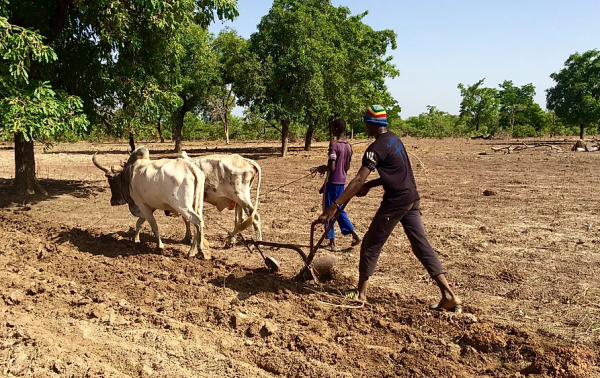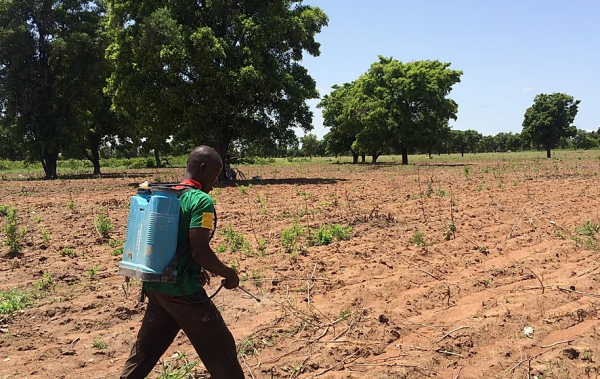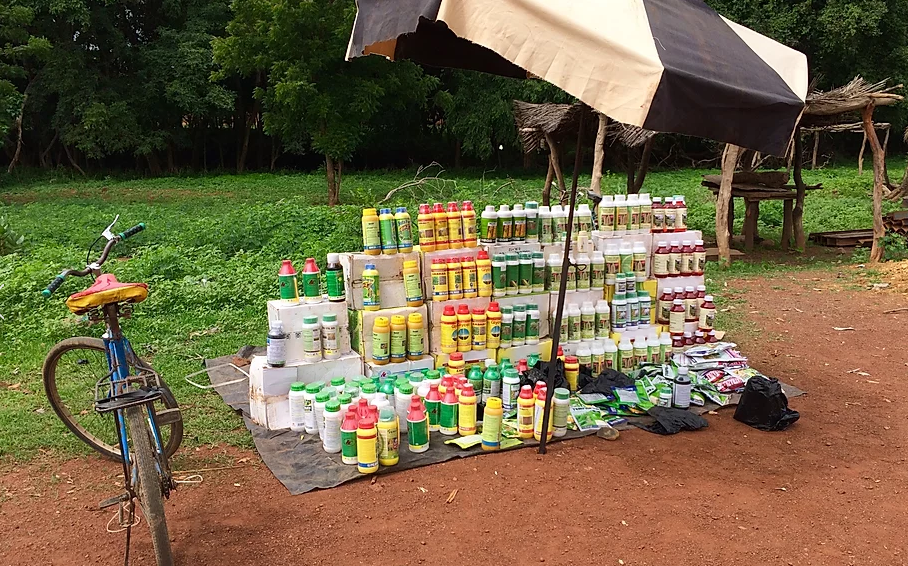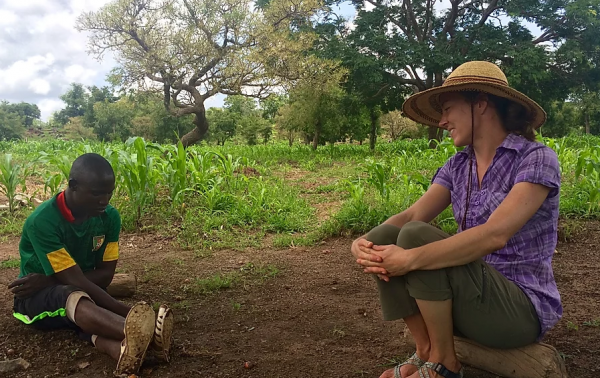Oxen plow soil, and women in loosely wrapped skirts plant seeds. A man applies pesticide from a backpack with a handheld sprayer. His hands are bare, but he wears shoes. And, he explains, “I don’t spray the row under my feet, I spray the next row over.”
Farm families collect drinking water from local streams – streams that pesticides have reached by seeping through the soil.
If the rains come… if the worms do not eat the cotton flowers…If the final cotton harvest is big enough to pay back all the debts that farmers owe…
They might earn more than just the typical one dollar per day for all their hard work.
These fields may seem like a remote corner of the planet, a speck on a map in rural Africa, but it is here where the world watched an important debate around genetically modified (GM) crops play out.

Burkina Faso, West Africa was the site of the first widespread commercial use of GM crops by small-scale farmers. This occurred from 2008 to 2016, and Dr. Jessie Luna, sociologist and assistant professor, spent time in 2016 conducting social science research on the effects of GM crop usage and the ensuing debates about its use.
Her findings revealed that rural people were often being essentialized in debates about GM crops – stereotypes were being used to portray and misrepresent them. As a result, inequalities around health, labor, and economics were being overlooked.
"We in Burkina, we export our soil and our sweat...those are the main ingredients. What are we left with? Tired soil and tired bodies." – Cotton Farmer


The GM debate
Debates around the risks and benefits of genetically modified organisms (GMOs) have been going on for decades, yet scientists and citizens around the globe remain divided. Developing areas like India and Africa have been closely watched to determine if GM crops are advantageous or not for farmers in less-industrialized countries. Burkina Faso has become the focus of this debate because it was the second African nation to commercialize GM crops, and the first to involve significant numbers of small-scale farmers. The world is watching: do GM crops have a future in Africa and what does this mean for producers and consumers of all scales around the world?
Monsanto, an American agri-business that has since been bought by multinational pharmaceutical and life science company Bayer, was one of the first to apply biotechnology to agriculture in the form of GM crops. Burkinabè cotton companies collaborated with Monsanto to cross insect-resistant Bt cotton from the United States with long-fiber Burkinabè varieties. In 2008, they sold this seed to Burkinabè farmers, and GM proponents quickly declared Burkina Faso a success story of higher yields and pest protection. But at the same time in Burkina Faso’s capital city, activists organized crowds of protestors to march against Monsanto.
Anti-GMO groups claim changing the genetic makeup of crops has far-reaching impacts down food and production chains that may not yet be known and that biotech corporations could eventually edge out small-scale farmers by monopolizing patents and charging high prices for seeds. Pro-GMO groups claim global production efficiencies, increased farmer livelihoods, fewer chemicals, and even the potential for additional nutrition and functions. A wide variety of factors play into each of these implications depending on local people and places.
Both sides of the GM cotton debate were surprised when the Burkinabè cotton sector ended its contract with Monsanto in 2016. The GM cotton’s shorter fiber was less desirable to textile manufacturers, and the Burkinabès claimed they were not only losing their international reputation for long-length cotton, but also billions of West African CFA francs (~US$80 million) in cotton sales. Monsanto claimed farmer error and pointed to research showing the benefits of GM crops.

The implications of whether Burkinabè GM crops were a success or not ripple around the world as consumers, producers, corporations, policymakers, and governments choose not only which seeds we plant in order to grow the food we eat, but also what kinds of policies we support and whether we publicly fund agricultural research or leave that to the private sector. Who wins, who loses, and who gets to decide are the complicated questions that social scientists like Dr. Luna ask. While the verdict may still be out regarding the safety and efficacy of GM crops in Burkina Faso, one thing is very clear: truths can be constructed in different ways.
“There is difficulty in sorting out knowledge that comes from differing perspectives. What do we do in a world now governed by soundbites?” asks Luna. “Even the very questions we ask can limit the range of the debate and the kind of knowledge we seek out. If we ask if GM crops are safe, and that’s the only question we ask, we might get an answer, but leave many other important questions unasked, and thus, unanswered.”
It is the job of sociologists to think critically and to help others do the same – to ask where information comes from, who the researchers are and who is funding them, how findings are being measured, what details are being left out, and where media source their facts.
Dr. Luna’s research looks at how the debate played out in Burkina Faso by examining how rural people were portrayed by both pro- and anti-GMO groups. Working with another researcher, she is also currently reviewing the underlying biases in many of the studies that were conducted to evaluate GM cotton, and how the general media used these Monsanto-funded studies as “evidence” that, in many ways, contradicted what she found to be true by living and working among the local Burkinabè farmers.


Economists (some funded by Monsanto) used abstracted mathematical models in their research, while Luna’s goal was to hear from people directly. She lived and worked alongside farmers and activists in Burkina Faso for five months. She was the first scientist to conduct research in the local language of Dioula, which she learned while serving in the Peace Corps years prior in the neighboring country of Mali.
Through the language, she was able to connect with residents. She had long conversations while helping farmers in their fields. She was invited to sip rounds of tea at the roadside.
Luna conducted over eight months’ worth of ethnographic research, 125 interviews and content analysis. She talked openly with government officials, research scientists, cotton company workers, Monsanto employees, activists, and male and female farmers varying in wealth and practice. She followed anti-GM activists to protests and attended pro-GM meetings.
She found surprisingly similar tactics being used by both pro- and anti-GM groups: both claimed to represent farmers, yet portrayed them in flattened, one-dimensional ways, instead of as being complex and diverse. GM critics depicted farmers as traditional peasants who save their seeds and grow in harmony with nature. GM proponents depicted farmers as backward peasants who need to be transformed into modern professionals following prescribed formulas.
Luna found that neither were accurate representations of the large number of Burkinabè farmers she got to know. “There’s a concerning tendency to homogenize or flatten farmers or peasants into categories,” says Luna. “But not all rural people have the same interests or concerns. The reality is that farmers have very different opinions based on their class and ideological positions.”
Both pro- and anti-GM groups were making claims for and about the farmers’ lives, and these falsities were obscuring the diverse struggles she found farmers were actually facing.
“I’m an old guy; I have a hard time putting on the backpack sprayer because it’s so heavy. Now I’ve been able to grow cotton again.”
“I really like them [GMOs], but I fell into debt because they just need to lower the price.”
“I no longer get insecticide poisoning during the cropping season.”
“We think ‘the only way I can pay back my credit is if I increase my production.’ But that’s not true! We just end up more indebted, continually running to pay our debt back! And we increase our acres and we tire ourselves out.”
Burkinabè people harvest their cotton by hand and haul it to weigh stations.
Although the public often focuses on the safety and health aspects of GMOs, they have paid less attention to how GM crops are actually being used by farmers. Luna’s work centers around why Burkinabè farmers adopt new agricultural technologies that deepen their ties to capitalism and increase social and environmental inequalities. She has found exploitation throughout the cotton supply chain – farmers who are exploited by the cotton sector also exploit their wives and children. Luna looks at how individuals justify their actions and the implications for human health, the environment, and economic stability.
Luna’s findings in West Africa inform conversations about broader and world-wide use of GMOs. Do GM crops feed people or leave them starving? Or, is this question itself too narrowly framed? What are the intended and unintended outcomes of utilitizing GM crops in the world’s differing spaces and places?
Her research urges people to consider the questions themselves: are we asking the right questions? How are they being answered, and by whom? How do we carefully evaluate the knowledge that we consume? Without this critical lens, debates over GM crops will only get more divisive and further removed from the realities of peoples’ lives.
She encourages us all to look beyond our pre-existing notions of rural people to consider the diversity of experiences, opinions, and living conditions. And, to think critically about context, “experts,” and “facts.”
“All knowledge must be subject to scrutiny,” she says.
Photos except for cover photo and headshot by Jessie Luna.
